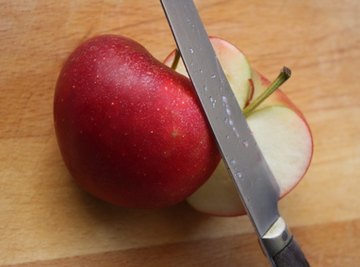
Enzymes can be incredibly difficult to understand in a textbook. To help students comprehend the enzyme model, use hands-on science projects that allow students to touch and manipulate objects that serve as representations for the parts, actions and reactions of enzymes. Spend a few class periods explaining and completing these projects, assign them to students as take-home projects or construct them for a science fair.
Enzyme-Substrate Model
This project focuses on the enzyme-substrate model and is adapted from Access Excellence. For an in-class project with a group of 30 students, you will need 500 pennies, 10 tennis balls, a stopwatch and masking tape. The first step in this project is called baseline. The teacher will divide students up into equal teams and drop 500 pennies onto the floor. Each team will choose one member to go over to the pile, pick up as many pennies as possible and turn them heads up. Students will do this six times, for ten second increments each time. The rest of the team members record how many pennies were picked up. After six rounds, redistribute the pennies to the floor pile. A new team member will attempt to pick up pennies and turn them heads up, but this time tape his four fingers, minus the thumb, together. This increased difficulty illustrates the partial denaturation of an enzyme, which can occur at high temperatures, in contact with acids, bases, or heavy metal ions.
The third phase will illustrate the role of a coenzyme. A new team member will pick up pennies but she will have a helper to turn them heads up for her, representing the coenzyme. The student will now have twice the time, 20 seconds, to pick up pennies and hand them to the coenzyme. To illustrate the concept of inhibitors, students will tape tennis balls to the palms of their hands and once again attempt to pick up pennies and turn them heads up. The tennis balls will represent the competition posed by inhibitors on enzymes.
Enzyme Art
Art projects are perfect for understanding enzymes, because the parts of a reaction (enzyme and substrate) fit like a puzzle, or lock and key. First, instruct students that enzymes are three-dimensional, and that they must create their own unique three-dimensional enzyme out of a material of their choosing. Instruct students to put a groove somewhere on the enzyme and label it “active site”. Label the piece the student cuts out to make the groove the "substrate." Then, instruct students to make 20 to 30 other substrates of similar sizes, but none of the exact same shape as the one cut out of the groove of the enzyme. The next day, students should bring their enzymes and substrates to class. Pair students up and have them trade their enzymes and substrates. Bring each pair up to the front of the class one at a time, and have them race to connect the correct substrate to the active site. When the first student fits the correct substrate into the active site, the class yells “Reaction!”
Enzyme Action
Once students understand the general structure and function of enzymes, it will help them to think about enzymes in action. The following lab attempts to teach the student how oxygen and pH affects browning on the inside of an apple, a visible enzymatic reaction. Gather an apple, lemon and paper plate for every student. Have the student bite one end of the apple and immediately rub lemon juice on it. Have them bite a hole on the other side of the apple and do nothing. In 15 to 30 minutes, the bite with the lemon will still be white while the other side becomes steadily more brown. Explain to the students that this occurs because of an enzyme present in apples called catecholase. When catechol and oxygen interact, the enzymatic reaction causes the apple to brown. The low pH of the lemon, however, stops this reaction.
References
About the Author
Michael Monet has been writing professionally since 2006. At the San Francisco School of the Arts, he studied under writers Octavio Solis and Michelle Tea, performed his work in Bay Area theaters and was published in literary journals such as "Paradox," "Umlaut" and "Transfer." Monet also studied creative writing at Eugene Lang College in New York and Mills College in Oakland.
Photo Credits
apple image by lefebvre_jonathan from Fotolia.com
